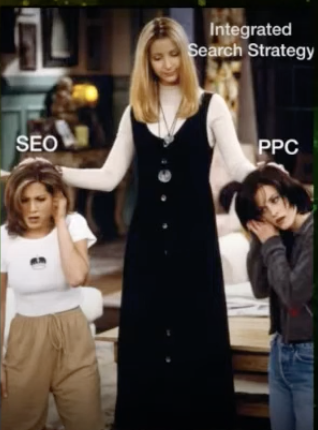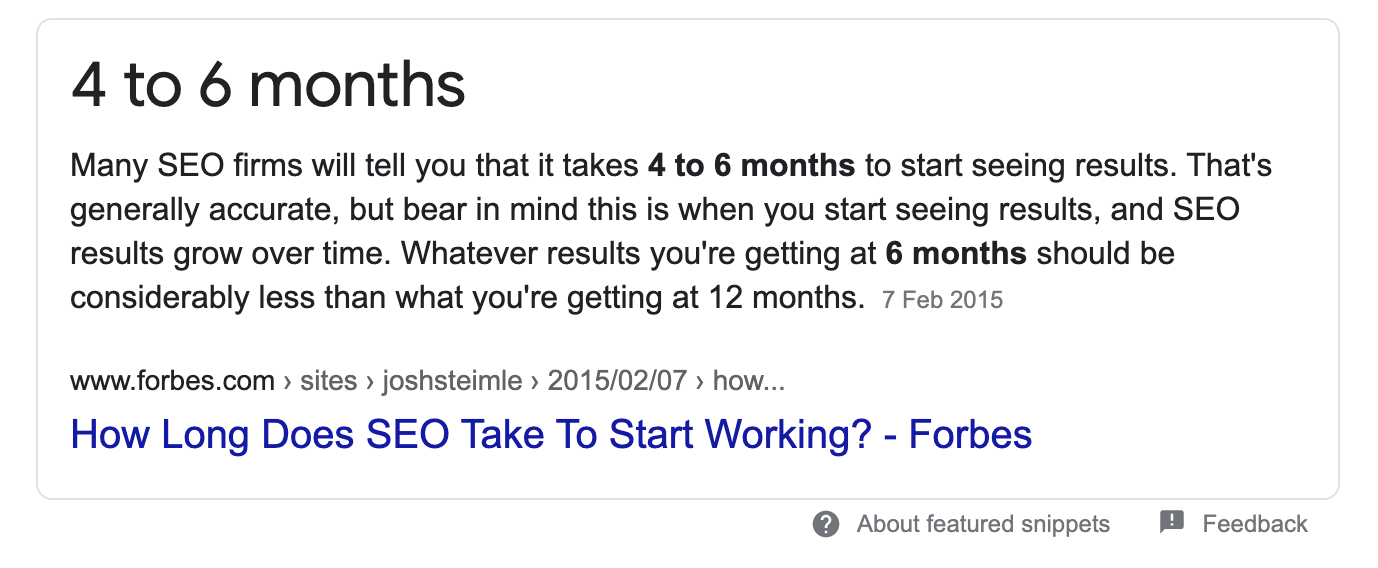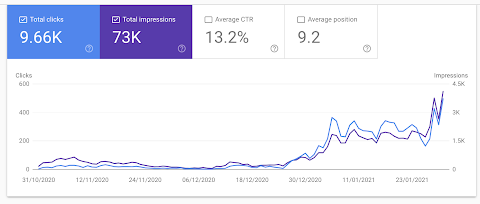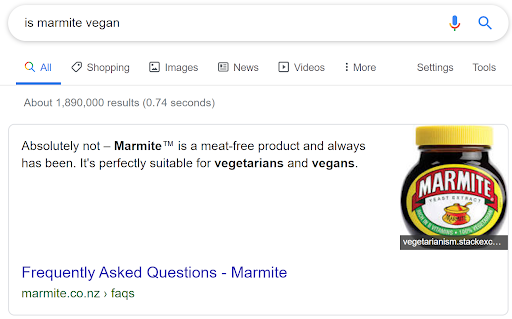SEO will, quite rightly, always play second fiddle to paid channels in terms of the speed and immediacy of results that you will see. The fabled old tale of the hare and the tortoise will be used as an analogy to justify the long-term benefits of investing in SEO now, compared to the ‘turn on the tap’ immediacy of paid.
Now this isn’t a bashing of paid channels, I have spent time on ‘the other side’ and have a desire for both channels to work in complete harmony and create a truly integrated search (and wider marketing) strategy. I talk about this in my Authoritas Tea Time SEO Talk below.
As I mentioned in the above webinar, it doesn’t have to be a zero-sum game between paid and organic search (for one to ‘win’, the other doesn’t have to ‘lose’) and they should complement, rather than be at loggerheads with, each other.

So, how long will it take to see SEO results?
In short, it depends (I did my utmost to avoid that phrase).
The typical retort, aside from the above, would be along the lines of the current featured snippet for that query from Forbes.
Now, any SEO will have countless tales of seeing incremental improvements and marginal gains over a longer period of time, with the fruits of their labour not evident until considerably further down the line.
The constant jostling and monitoring of keyword performance over time can both be captivating and frustrating, with weekly, daily and even hourly ranking changes. Not to mention, query intent shifts, with external factors changing the perceived intent for that keyword, for example is someone searching for ‘Wren’ looking for wildlife or kitchens? Try my quiz on Search Intent below.
This slow, incremental growth is most commonly seen for particularly competitive terms. However, SEO being long-term and PPC being short-term isn’t entirely true. You need to think how soon you need results, as well as the investment that you have available. You will often see an initial learning phase with paid activity (particularly if you haven’t ran any activity previously) before you stumble across a winning account structure and keyword targets (while stripping out any terms that are eating your budget).
So, when can you see quicker results?
If you have a technically sound and established site, there’s no reason why you can’t see quicker results, with five key ways listed below;
1. Reacting to new terms
At the centre of any successful SEO campaign is a clearly defined list of keyword / topical targets. However, where some people can go wrong is identifying your targets at one point in time and becoming too blinkered by them (and only them).
Let’s not forget that 15% of all searches are brand new, never seen before queries (confirmed by the Google Search Liaison team in the below thread, with it possibly being even higher due to Covid). This gives search marketers (across both paid and organic) a whole wealth of new, untapped keyword opportunities.
Anyone have more recent "affirmation" of the 15% new daily search stat? https://t.co/02TSybCzuH cc @rustybrick @sengineland @JohnMu @methode
— Gyi Tsakalakis (@gyitsakalakis) August 27, 2020
Take, for instance, this B2B example. The topic of this particular blog post didn’t exist two years ago. We had a number of individual blog posts on this topic and consolidated them into a regular updated, ultimate guide on the topic which has usurped a number of industry leading publications. Not only has this sent a healthy amount of additional traffic to the site, it has also facilitated a shift in their service offering to provide consultancy around this particular industry hot topic.
N.b Ultimate Guides aren’t always the way to go.
2. Seeing which new terms we’re getting traction for
Monitoring any large uplifts in impressions, can peak the interest of SEOs and lead to a wealth of new opportunities. Using Hannah Rampton’s Google Search Console Explorer tool, we saw that we had a huge increase in impressions for some topical, high intent queries for one particular client. Upon closer inspection, the page that was being served wasn’t created for that purpose and received very little traffic. However, it had quickly gained a strong average position for these new terms.
I like to use the above tool from Hannah, alongside Google Trends data to get a more complete picture of any increases in search interest. Our very own, Simon Thompson, created a super handy Google Trends connector for Google Data Studio for this very purpose, which is invaluable for this type of analysis.
So, we shifted the focus and made it about these new terms and quickly secured position 1 across the two highly searched queries.
The above isn’t based on seasonality and, is instead, a highly relevant term now.
3. Upcycling Content
The emphasis has long been on creating new content. However, revisiting old content and adding more value to it is, arguably, a better use of time and resources. See my presentation on ‘Why You Need To Stop Mindlessly Creating New Content’ below.
One such example was a guide that was heavily linked to a best selling product for one of our clients. Consumers needed advice and information to help inform their purchase decision. When reviewing the search behaviour around this product, we found a number of additional questions and advice that we could add to the guide to make it the best resource on the topic, as well as featured snippets to target.
The result? An almost immediate uplift in traffic (see the annotation for when this was published in the graph below).
This did coincide with an increase in search interest, around the start of the onset of the global pandemic.
Furthermore, targeting terms that currently occupy positions 8-15 in the search results, provide a fantastic platform to be upcycled and to start moving them into traffic-driving positions.
To support this updated content, it’s worth reviewing any additional internal link opportunities and how you can signpost more users to this content. If it’s particularly key to your business, then bring it closer to the Homepage and make it as easy as possible for users and search engines alike.
4. Targeting Featured Snippets
While this was central to the above performance improvements, it does warrant its own section too. Featured snippets are the much sought after ‘answer boxes’ within the search results, like the aforementioned example from Forbes.
As a typical rule of thumb, you can only target these if you’re in the top 5 positions within the search results. Effectively, if the search query triggers an answer box, then it’s a free-for-all for those within the higher echelons of the search results. Ultimately, Google values your content if it’s rewarding you in these positions which makes it attainable for you.
Framing your content based on the format and length of the snippet, as well as looking to add more value than the current incumbent (which is particularly attractive if the snippet uses elipsis (…) in the result). But, be careful with how you frame your content, as it can lead to instances like this.
5. Page Title Changes
Now, many SEOs will simply stuff their target keyword into the title tag (to good effect). However, there is a balance to be found and it should also be informed by high performing headlines from your paid activity too. I like this below advice from Content Lead at Shopify, Kameron Jenkins;
Your title tag is like a movie trailer.
People use it to help them decide whether they want to invest time in viewing the whole thing.
So think beyond "is it 50-60 char. & include the keyword?" and ask:
Is it descriptive?
Compelling?
Engaging?Give people a reason to click.
— Kam Jenkins (@Kammie_Jenkins) February 16, 2021
So, there you have it, organic search doesn’t have to be the channel that takes forever to see results. I’m not saying that instant results are the norm or possible across the board, especially if the key technical underpinnings aren’t in place, but there are often opportunities that are right under our noses, that are just waiting to be tapped into. The key is being agile, inquisitive and constantly reviewing performance.





